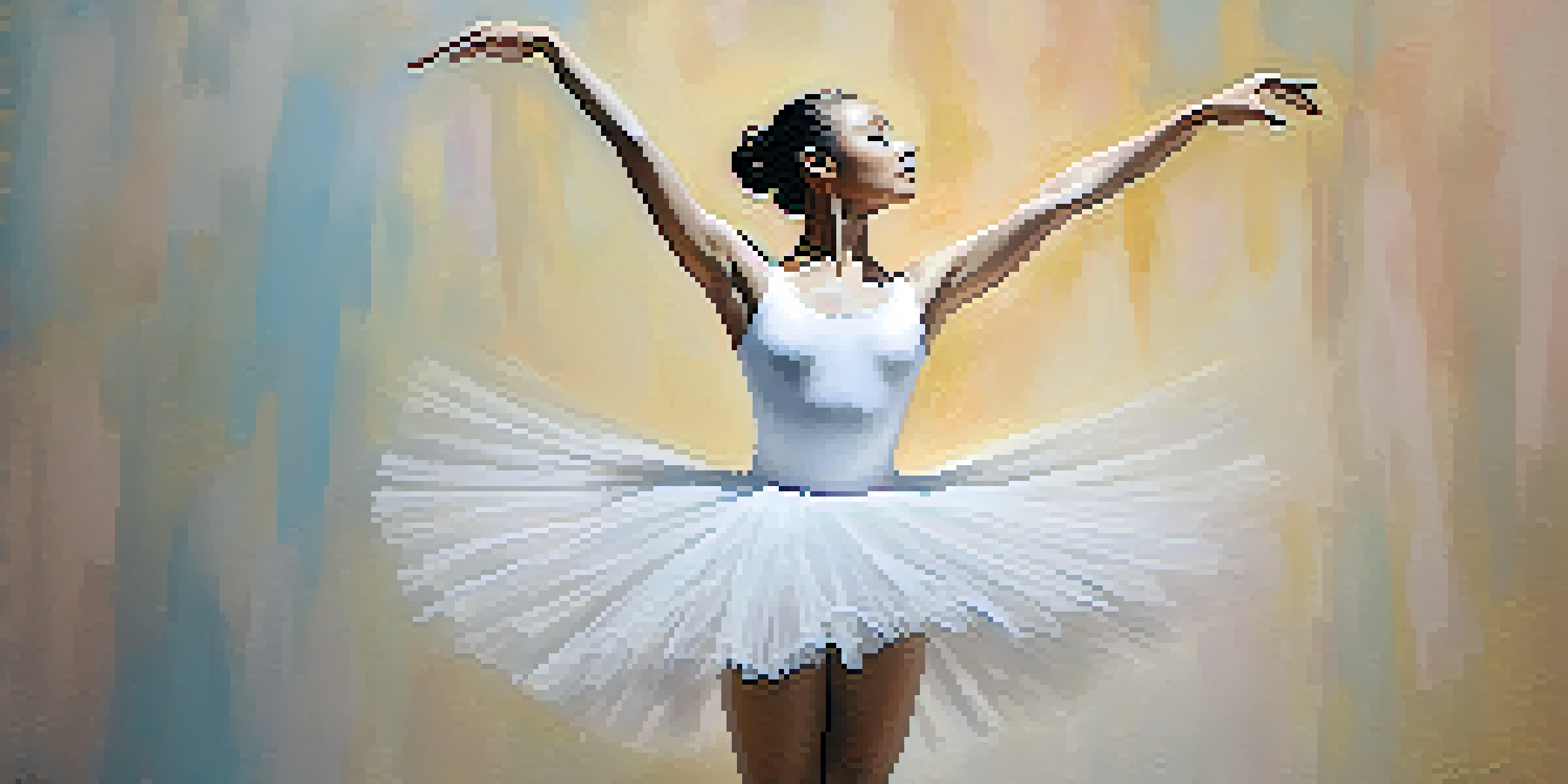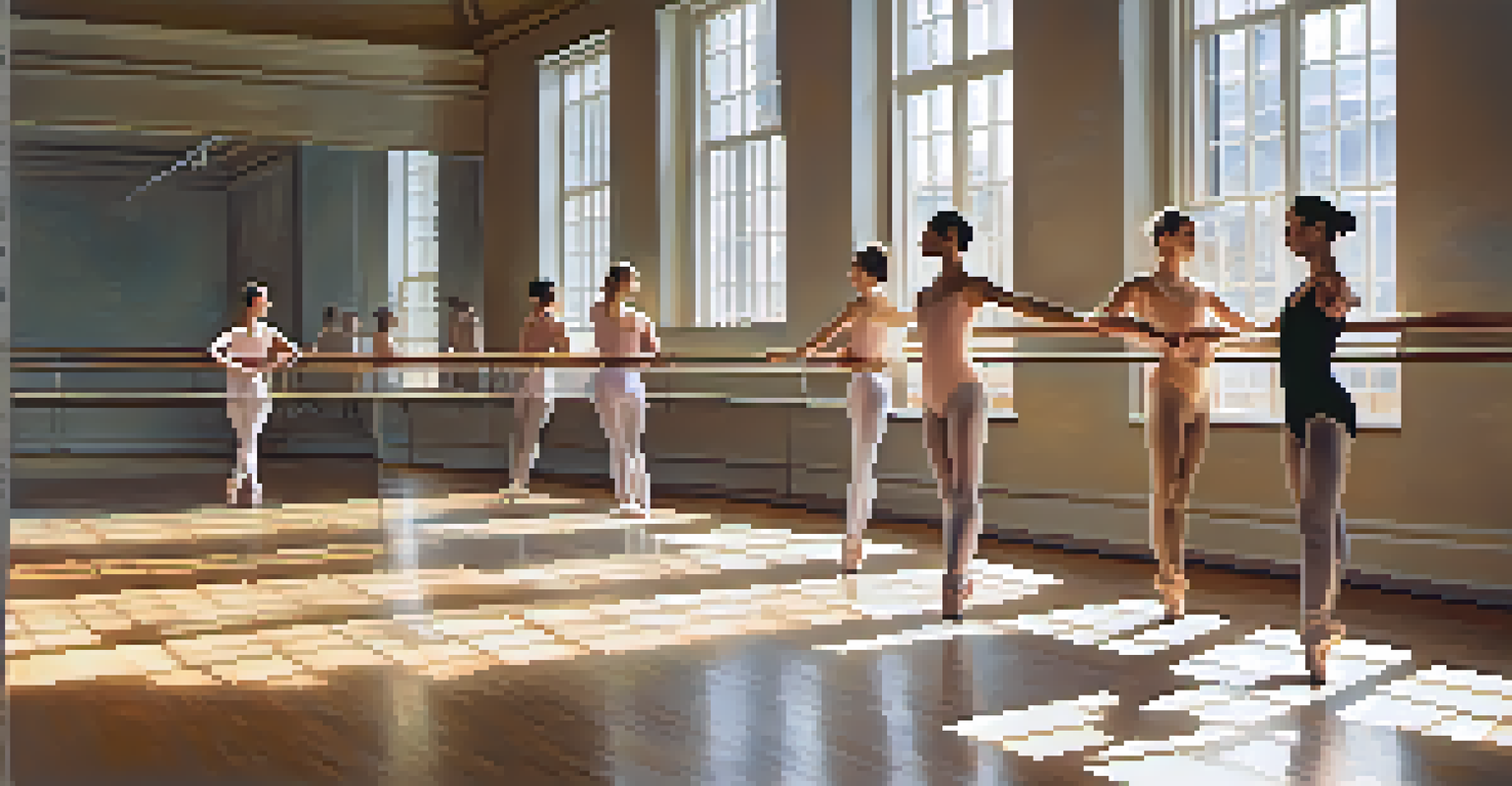Understanding the Role of Musicality in Ballet Performance

What is Musicality in Ballet Performance?
Musicality in ballet refers to a dancer’s ability to interpret and express music through movement. It’s not just about dancing in time with the music; it’s about embodying the nuances and emotions that the music conveys. Think of it as a conversation between the dancer and the music, where each step and gesture reflects the musical phrases.
Dance is the joy of movement and the heart of life.
In ballet, musicality is essential for creating a captivating performance. Dancers must connect with the rhythm, melody, and dynamics of the music to truly bring their choreography to life. This connection allows them to express a wide range of emotions, from joy to sorrow, making their performance more relatable and engaging for the audience.
Ultimately, musicality elevates a dancer’s artistry. A technically skilled dancer may impress with their precision, but when they infuse their performance with musicality, they create a magical experience that resonates deeply with viewers.
The Connection Between Music and Movement
The relationship between music and movement in ballet is symbiotic. Music provides the framework for the choreography, while the dancer's movements breathe life into the music. This interplay creates a dynamic experience that goes beyond mere performance, captivating both the dancer and the audience.

Consider a waltz; its flowing rhythms naturally lend themselves to sweeping, graceful movements. A dancer who is attuned to these musical contours can enhance the performance by accentuating the rise and fall of the music in their movements. This kind of connection makes the dance feel more organic and immersive.
Musicality Enhances Dance Expression
A dancer's ability to interpret music through movement transforms performances into emotional journeys.
Moreover, this connection helps dancers anticipate musical changes, allowing them to react instinctively. This responsiveness not only showcases their skill but also enhances the overall performance, making it a shared journey between the dancer and the audience.
Musicality Skills Every Dancer Should Develop
To fully embrace musicality, dancers should work on several key skills. First among these is rhythm, which involves understanding the beat and tempo of the music. Exercises such as clapping or tapping along to different musical pieces can help dancers internalize the rhythm, making it easier to synchronize their movements.
Music can change the world because it can change people.
Another important skill is phrasing, which refers to the way music is structured into sections. Dancers should learn to recognize musical phrases and build their movements to reflect these natural breaks and climaxes in the music. This not only enhances the performance but also helps in storytelling through dance.
Finally, emotional expression is crucial. Dancers should explore how different types of music evoke various feelings and translate those emotions into their movements. This emotional connection makes performances not just visually appealing but also deeply resonant.
The Role of Music Selection in Ballet
Music selection plays a pivotal role in shaping a ballet performance. The choice of music can influence the mood, pacing, and style of the dance, and it’s essential for choreographers to select pieces that align with their vision. For example, a dramatic score may inspire powerful, dynamic movements, while a soft melody might evoke gentler, more delicate choreography.
Additionally, the familiarity of the music can impact a dancer’s performance. Dancers often feel more confident and expressive when they can connect with a piece they know well, allowing them to focus on their movements rather than trying to interpret new sounds on the spot.
Music Selection Shapes Performance
Choosing the right music influences the mood and style of a ballet, creating a cohesive narrative.
Ultimately, the right music can elevate a performance, creating an unforgettable experience for both the dancer and the audience. It underscores the narrative being told through dance, making the entire performance feel cohesive and impactful.
How Musicality Enhances Performance Quality
Musicality significantly enhances the quality of a ballet performance by adding depth and artistry. When dancers move in sync with the music, their movements become more expressive and fluid. This synchronization allows the audience to feel the energy of the performance, turning a simple dance into a moving experience.
Moreover, dancers who demonstrate strong musicality often stand out in competitions and auditions. Judges are not just looking for technical perfection; they also seek performers who can convey emotion and tell a story through their movements. A dancer who embodies the music can leave a lasting impression.
In essence, musicality transforms a performance from a series of technical steps into an emotional journey. It allows dancers to communicate with their audience on a deeper level, making the art of ballet not just about movement, but about connection.
The Influence of Dance Training on Musicality
Dance training plays a crucial role in developing a dancer’s musicality. Through structured classes, dancers learn to understand music theory, rhythm, and phrasing, which are all vital components of musicality. Instructors often emphasize the importance of listening to music while rehearsing, highlighting how it can inform their movements.
Additionally, exposure to various music styles during training can broaden a dancer’s musical palette. This versatility allows dancers to adapt their movements to different genres, from classical to contemporary, enriching their overall performance capabilities. It encourages creativity and innovation in their choreography.
Musicality Skills Boost Versatility
Developing musicality skills enhances a dancer's performance across various genres, enriching their artistic expression.
Ultimately, comprehensive training that incorporates musicality leads to more well-rounded dancers. They become not only skilled technicians but also expressive artists who can engage audiences in meaningful ways through their interpretation of music.
The Benefits of Musicality Beyond Ballet
Musicality isn’t just beneficial for ballet; it can enhance a dancer’s overall artistic expression in any genre. The skills developed through musicality—like timing, rhythm, and emotional interpretation—are transferable to other dance forms, such as jazz, contemporary, or even hip-hop. This versatility can open up new opportunities for dancers.
Additionally, exploring musicality can foster a deeper appreciation for music itself. Dancers who engage with music on this level often develop a lifelong love for various genres, enriching their artistic journeys. This connection can lead to collaborations with musicians, creating multi-disciplinary art forms.

In a broader sense, the lessons learned from musicality can also apply to life beyond dance. The skills of listening, interpreting, and expressing can enhance communication and creativity in everyday scenarios, illustrating that the impact of musicality extends far beyond the stage.